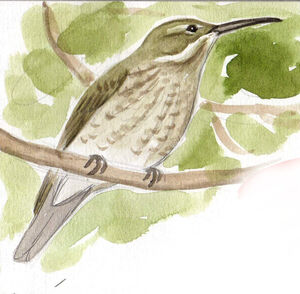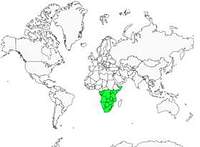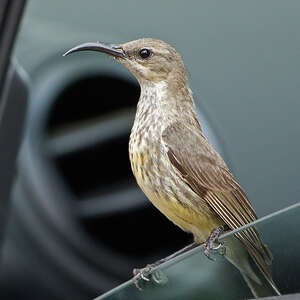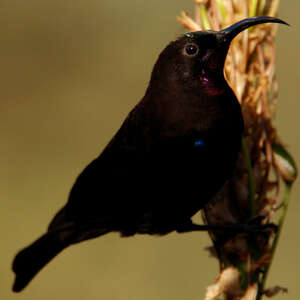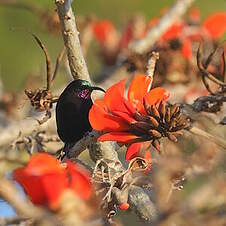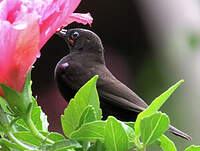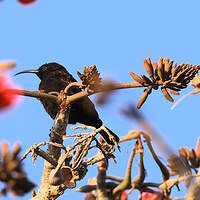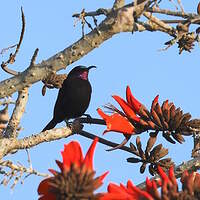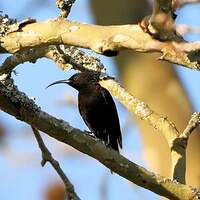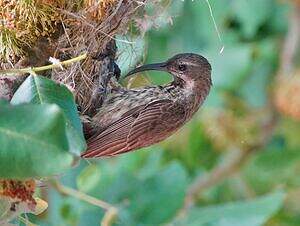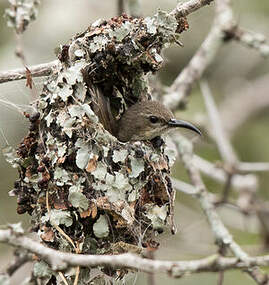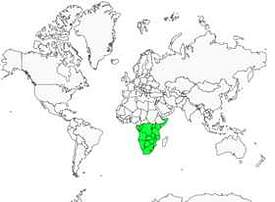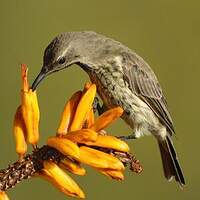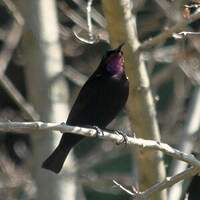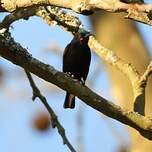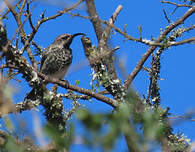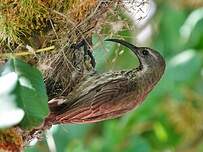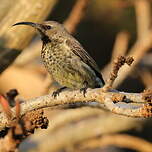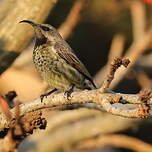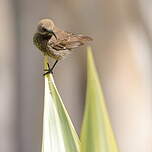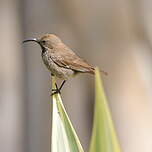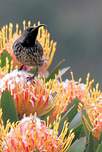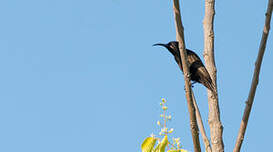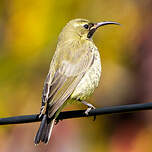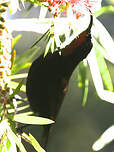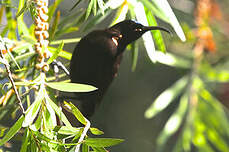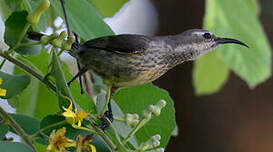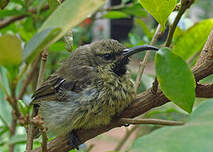Amethyst Sunbird
Chalcomitra amethystina - Souimanga améthyste
Identification
The Amethyst Sunbird is quite large, it is equipped with a long, clearly curved beak in the shape of a sickle. The dimorphism is clearly visible between the two sexes. The male, which could appear entirely black, possesses small, clearly visible iridescent parts under good light, due to the iridescence of the feathers. When seen from the front and with a good angle, the head of the Amethyst Sunbird is remarkably iridescent and scaly. The crown is metallic blue-green, the chin and throat are pink-fuchsia blue. In this same position, two small pink-violet to blue spots are visible on the shoulders. The beak is shiny black, the iris is dark brown and the legs are black. The wings are dark brown to black-brown and the rest of the body is black. The immature male has only a pink-violet iridescent spot on the throat. The female, whose general appearance is clear, can be confused with other females of the same species whose distribution zones are identical and which can be found in the same habitats. This is the case with the female Red-breasted Sunbird and Mariqua Sunbird. Here our female has the upper parts gray-brown tinged with olive. A light eyebrow and pale yellow-white mustaches stand out from the uniform head. The iris is dark brown, the beak is black. The yellowish throat is marbled with brown, sometimes so densely that it appears black. The underside is brownish yellow finely striped with fawn. The coverts are dark brown, the remiges are dark gray-brown with fawn borders, paler on the primary remiges. The tail is brown blackish with white-grayish ends. The juvenile looks like the female with the darker throat and the lower parts spotted and yellowish. Four subspecies are recognized in the Amethyst Sunbird. These subspecies differ in the females by the amount of marble and stripes on the throat and lower parts.The male of the kirkii subspecies has blue-fuchsia pink plumage on its rump. The male of the deminuata subspecies has a slightly smaller bill.
Subspecific information 4 subspecies
- Chalcomitra amethystina amethystina (se Botswana, s Mozambique and South Africa)
- Chalcomitra amethystina kalckreuthi (s Somalia, e Kenya and ne Tanzania)
- Chalcomitra amethystina kirkii (South Sudan, Uganda, w and c Kenya, and s Tanzania to e Zambia, Zimbabwe and c Mozambique)
- Chalcomitra amethystina deminuta (se Gabon and s Congo to sw DRCongo, Angola, c, w Zambia, n Botswana and n Namibia)
Foreign names
- Souimanga améthyste,
- Suimanga amatista,
- nectarínia-ametista,
- Amethystglanzköpfchen,
- ametiszt nektármadár,
- Amethisthoningzuiger,
- Nettarinia ametista,
- ametistsolfågel,
- Ametystsolfugl,
- nektárovka ametystová,
- strdimil ametystový,
- Ametystsolfugl,
- samettimedestäjä,
- Swartsuikerbekkie,
- suimanga ametista,
- nektarnik ametystowy,
- Аметистовая нектарница,
- アメシストタイヨウチョウ,
- 艾米花蜜鸟,
- ametistsolfågel,
- 紫晶花蜜鳥,
Voice song and call
The song of the Amethyst Sunbird is quite complex. It consists of a succession of fast ascending and descending chirps: chip-chip-chip-chee or der-chip-cher-chu. The female also emits some chirps, which allows the couple to perform duets. The most common call sound is a single chip or tschiek. There are other variants including chup as well as zit-zit and zeebe-zeebu, tzwit-tzuit-zit and the like, chip and chop, chip-chop, cher-chip or cher-chop or chip-chip or ptcher-chiiizzz ending with a wheezing breath. During pursuits between individuals, it emits: chee, chee, chee, chee or ssweek-ssweeek-ssweeek Alarm calls are varied: t,t,t,t,t,t,t... or it-jit-jit-jit... or choy, tit-choy, tit-chree.
Habitat
The Amethyst Sunbird lives and breeds in an open woodland environment. It can be found in dry savannah forests and their edges, wet wooded plains, near the shores of large lakes and ponds, as well as the last remaining forests in the main capital cities such as Nairobi, Kenya, and in small and large gardens of lodges and private properties if the inhabitants are planting aloe and protea.
Behaviour character trait
The Amethyst Sunbird is a resident bird in its range. It may locally undertake partial migrations according to the months of the year and the region. It lives alone or in pairs, and in the same way it feeds alone or in pairs, on the ground or in the foliage. Small and agile, it easily weaves through branches, among flower stalks and lianas and does not miss the opportunity to do some acrobatics in order to feed, including hovering in front of flowers.
Dietfeeding habits
The Amethyst Sunbird feeds on insects, including termites, spiders which it directly takes from webs, and of course nectar from flowers.
Its long, scissor-like bill allows it to reach deep inside tubular or bell-shaped flowers. It accomplishes this using hovering flight or simply sitting on flower stems or stalks. It also glean through foliage for aphids and hunts for flying insects just like a flycatcher. Finally, it is not unusual to find it foraging on the ground on fallen fruits. New to this behavior, it has started to visit waterholes in South Africa, which so far has been seen only in South America by Trochilidae.Reproduction nesting
The breeding season of the Amethyst Sunbird is generally all year round, with different periods depending on the species distribution. In East and Southern Africa for example, the Amethyst Sunbird breeds throughout the year while in Somalia nesting only occurs in August. In Angola, it is recorded in May, October and December, in Malawi from September to February and in April, in Zambia from August to March, in Zimbabwe from July to April, in Mozambique only in January, and from October to March in Botswana. At the breeding season, the male courts the female, constantly harassing her.
The nuptial parade is distinguished by small jumps, wing lowering, in the first place one after the other, then both simultaneously to end with rapid wing beats. Once courted, the consenting female lowers her head and stays still. The nest, suspended on a tree, on an electric wire or another bare wire, is located between 2 and 6 meters from the ground. It is built by the female alone. In the shape of a pear it is made up of thin grasses, fibers, wool, hairs, bark, small pieces of wood, cobwebs and lichens. The interior is lined with feathers or flower petals. The lateral entrance is protected by a porch. The female lays 1 to 4 eggs, usually 2, whitish to greenish or light gray marked with brown spots, splotches or dark brown, olive brown or gray stripes. She incubates alone for 13 to 18 days, the chicks are then fed by both parents for 17 days. The young remain dependent on the parents for some days after their flight. The Amethyst Sunbird is parasitized by Klaas's Cuckoo, the Foliotocol Cuckoo and the Gray Indicator.Geographic range
The Amethyst Sunbird is common throughout much of its range, extending from northern Kenya to southern South Africa albeit absent from much of Mozambique. It is also found in Gabon, Angola, Namibia, Zambia and Botswana. It has only very small and restricted distributions in Somalia, Sudan and Uganda. Its presence is now uncertain in southeastern Ethiopia with only three reports, all of which need to be corroborated. In August 2010, a first sighting of a pair was made in southeastern Rwanda.
Threats - protection
IUCN conservation status
concern
in the Wild
threatened
evaluated
The Amethyst Sunbird is not threatened. Its presence in several protected areas such as Arusha and Mikumi National Parks in Tanzania, Dzalanyama Reserve and the Lilongwe Nature Sanctuary in Malawi allows it to maintain its current conservation status for the moment.
Sources of information
- IOC World Bird List (v15.1), Gill, F and D Donsker (Eds). 2025-12-07.
- Birds of the World, The Cornell Lab of Ornithology
- eBird, Cornell Lab of Ornithology et National Audubon Society
- African Bird Club,
Other sources of interest
 Specification sheet created on
16/07/2023 by Nathalie Santa Maria
Specification sheet created on
16/07/2023 by Nathalie Santa MariaTranslation by AI Oiseaux.net
© 1996-2025 Oiseaux.net
- Accipitriformes
- Aegotheliformes
- Anseriformes
- Apodiformes
- Apterygiformes
- Bucerotiformes
- Caprimulgiformes
- Cariamiformes
- Casuariiformes
- Charadriiformes
- Ciconiiformes
- Coliiformes
- Columbiformes
- Coraciiformes
- Cuculiformes
- Eurypygiformes
- Falconiformes
- Galliformes
- Gaviiformes
- Gruiformes
- Leptosomiformes
- Mesitornithiformes
- Musophagiformes
- Nyctibiiformes
- Opisthocomiformes
- Otidiformes
- Passeriformes
- Pelecaniformes
- Phaethontiformes
- Phoenicopteriformes
- Piciformes
- Podargiformes
- Podicipediformes
- Procellariiformes
- Psittaciformes
- Pterocliformes
- Rheiformes
- Sphenisciformes
- Steatornithiformes
- Strigiformes
- Struthioniformes
- Suliformes
- Tinamiformes
- Trogoniformes

